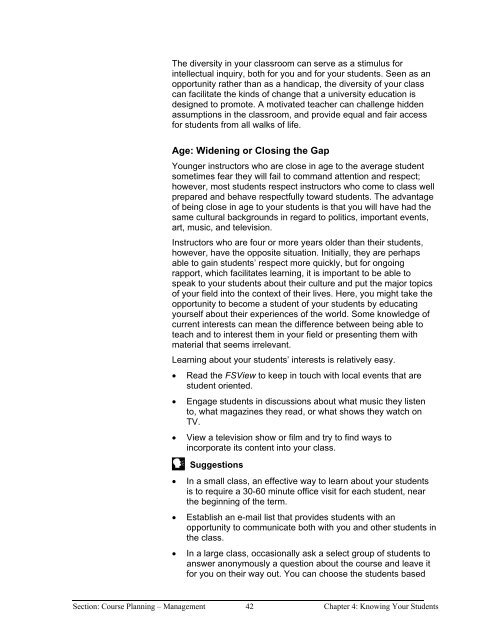Chapter 9 - Instructional Media: Chalkboards to Video - CGISS
Chapter 9 - Instructional Media: Chalkboards to Video - CGISS
Chapter 9 - Instructional Media: Chalkboards to Video - CGISS
Create successful ePaper yourself
Turn your PDF publications into a flip-book with our unique Google optimized e-Paper software.
The diversity in your classroom can serve as a stimulus for<br />
intellectual inquiry, both for you and for your students. Seen as an<br />
opportunity rather than as a handicap, the diversity of your class<br />
can facilitate the kinds of change that a university education is<br />
designed <strong>to</strong> promote. A motivated teacher can challenge hidden<br />
assumptions in the classroom, and provide equal and fair access<br />
for students from all walks of life.<br />
Age: Widening or Closing the Gap<br />
Younger instruc<strong>to</strong>rs who are close in age <strong>to</strong> the average student<br />
sometimes fear they will fail <strong>to</strong> command attention and respect;<br />
however, most students respect instruc<strong>to</strong>rs who come <strong>to</strong> class well<br />
prepared and behave respectfully <strong>to</strong>ward students. The advantage<br />
of being close in age <strong>to</strong> your students is that you will have had the<br />
same cultural backgrounds in regard <strong>to</strong> politics, important events,<br />
art, music, and television.<br />
Instruc<strong>to</strong>rs who are four or more years older than their students,<br />
however, have the opposite situation. Initially, they are perhaps<br />
able <strong>to</strong> gain students’ respect more quickly, but for ongoing<br />
rapport, which facilitates learning, it is important <strong>to</strong> be able <strong>to</strong><br />
speak <strong>to</strong> your students about their culture and put the major <strong>to</strong>pics<br />
of your field in<strong>to</strong> the context of their lives. Here, you might take the<br />
opportunity <strong>to</strong> become a student of your students by educating<br />
yourself about their experiences of the world. Some knowledge of<br />
current interests can mean the difference between being able <strong>to</strong><br />
teach and <strong>to</strong> interest them in your field or presenting them with<br />
material that seems irrelevant.<br />
Learning about your students’ interests is relatively easy.<br />
• Read the FSView <strong>to</strong> keep in <strong>to</strong>uch with local events that are<br />
student oriented.<br />
• Engage students in discussions about what music they listen<br />
<strong>to</strong>, what magazines they read, or what shows they watch on<br />
TV.<br />
• View a television show or film and try <strong>to</strong> find ways <strong>to</strong><br />
incorporate its content in<strong>to</strong> your class.<br />
Suggestions<br />
• In a small class, an effective way <strong>to</strong> learn about your students<br />
is <strong>to</strong> require a 30-60 minute office visit for each student, near<br />
the beginning of the term.<br />
• Establish an e-mail list that provides students with an<br />
opportunity <strong>to</strong> communicate both with you and other students in<br />
the class.<br />
• In a large class, occasionally ask a select group of students <strong>to</strong><br />
answer anonymously a question about the course and leave it<br />
for you on their way out. You can choose the students based<br />
Section: Course Planning – Management 42 <strong>Chapter</strong> 4: Knowing Your Students
















